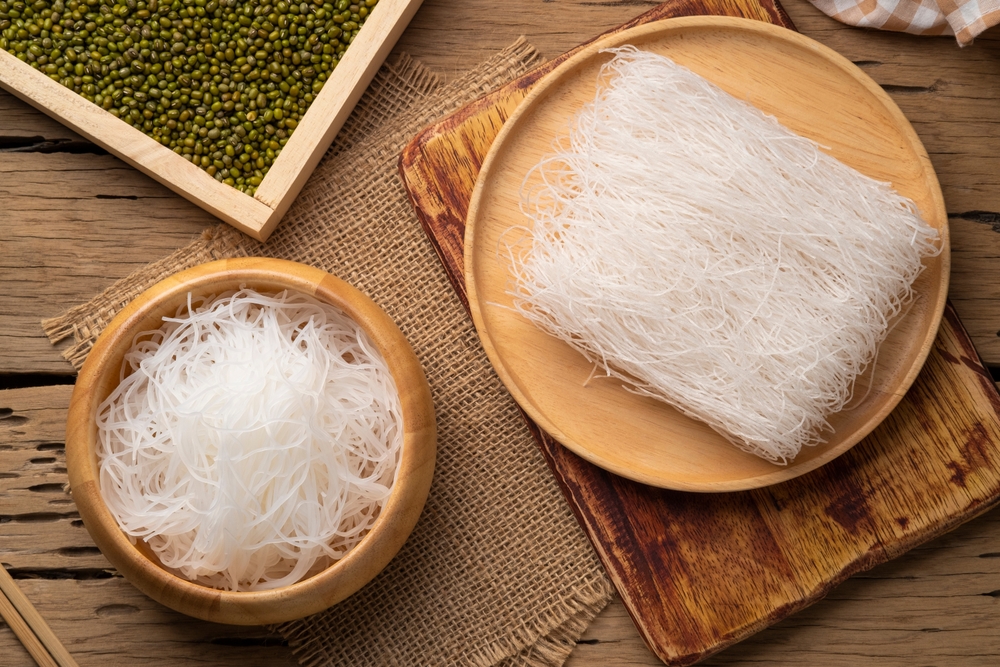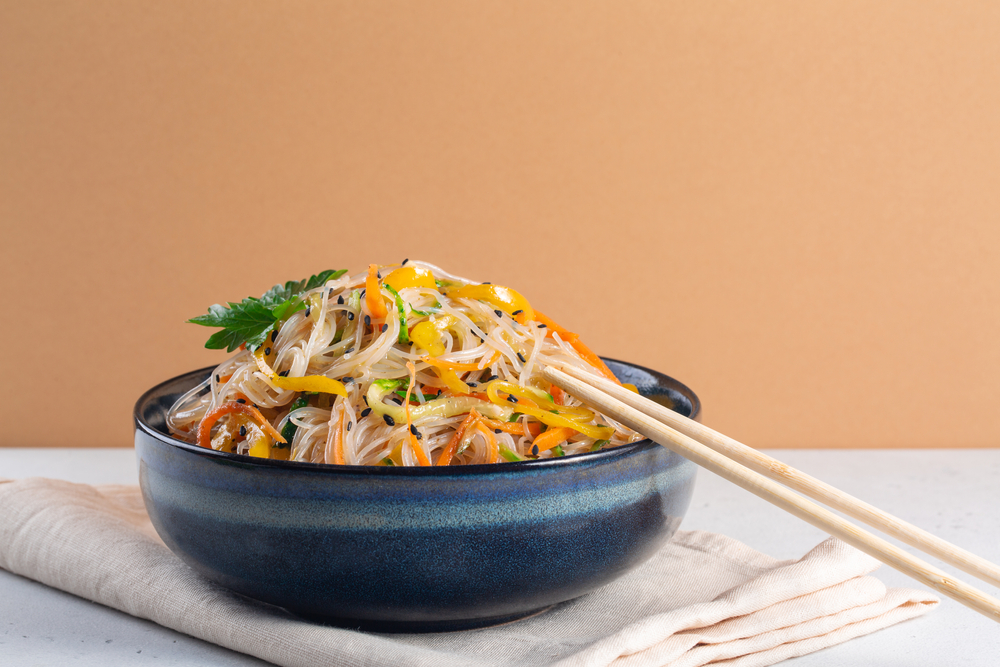Glass noodles, cellophane noodles, or bean thread noodles are transparent and chewy because they are created from mung bean starch, water, and sometimes tapioca or potato starch. They don’t increase blood sugar, so their low glycemic index makes them good for regulating it.
Their sugar-free nature is ideal for low-sugar diets that lower cholesterol, blood pressure, inflammation, and diabetes. They improve digestion, reduce cholesterol, and are gluten-free for gluten-sensitive people. They are fat-free, which aids weight reduction and lowers obesity and cardiovascular disease risk. Glass noodles also contain iron for oxygen delivery and fat burning.
In many cuisines, they are healthier than other noodles thanks to their decreased calorie content. That’s why adding glass noodles to a balanced diet with nutrient-dense foods, including lean proteins, veggies, and healthy fats, will help you reach your health objectives.
Nutritional Benefits
Calorie, Carb, and Fiber Content of Glass Noodles
Glass noodles provide 160 kcal per 1-cup serving (190 grams). They are high in carbs, 39.3 grams per serving, for energy. Though low in fiber at 0.9 grams, they promote intestinal regularity. Glass noodles offer 0.076 grams of protein and 0.019 grams of fat per serving. They also include phosphorus (13.3 mg) and potassium (3.8 mg) for bone and muscular health. Thus, due to their nutritional features, glass noodles may complement low-calorie, low-carb diets.
Benefits of Gluten-Free, Low-Calorie, and Low-Carb Diets
Glass noodles benefit several particular diets. They replace wheat-based noodles on gluten-free diets for lower digestive difficulties and better energy and digestion. They are gluten-free, unlike rice noodles, which may contain trace gluten via cross-contamination. Their modest calorie composition helps low-calorie diets control weight while delivering satisfaction from high carbohydrate content. A low-carb diet may benefit from glass noodles’ 20–45 glycemic index. It slows glucose release, decreasing blood sugar spikes and increasing energy and metabolic health.
Growing Demand for Healthier Noodle Options
Health awareness is driving demand for healthier noodle choices, including glass noodles. Healthy options like low glycemic response, gluten-free, and reduced fat are becoming popular. With glass noodles, Phad Woon Sen and Yum Woon Sen Talay are delightful health-conscious meals and versatile enough for classic and creative cuisines. Dietary modification and lifestyle-related health concerns such as obesity, diabetes, and celiac disease are fueling this need. Hence, those pursuing an equitable and health-conscious diet are turning to glass noodles.
Culinary Flexibility
Spicy Glass Noodle Salad
Spicy Glass Noodle Salad shows how flexible glass noodles are. Let’s consider an example here. You may choose to use 200 grams of rehydrated glass noodles to prepare this meal. Then, add 50 grams of julienned bell peppers, carrots, and cucumbers for crunch and color. Use 150 grams of thinly sliced grilled chicken breast for lean protein. The dressing is important: 2 tablespoons fish sauce, two tablespoons lime juice, one tablespoon soy sauce, one teaspoon sugar, and a finely chopped Thai chili for heat. To add freshness, mix everything with cilantro and mint. For numerous diets, it is visually pleasing, low-glycemic, high-fiber, gluten-free, and fat-free.
Glass Noodle Soup
Low-fat, high-iron Glass Noodle Soup is soothing and healthful. For example, you may start by simmering 1 liter of chicken or vegetable stock with two cloves of garlic and a 2-inch ginger piece for 30 minutes to make a clear broth. The broth can include 100 grams of rehydrated glass noodles, 50 grams of sliced mushrooms, napa cabbage, and spinach. Add 100 grams of soft tofu for protein and texture. Add one tablespoon of low-sodium soy sauce and a dash of white pepper to season. Simmer for 10 minutes to tenderize veggies and cook noodles. The soup contains iron and less kcal and fat per serving for weight loss. It’s good for metabolic health and a hearty meal.
Tips for Food Manufacturers
Glass noodles in health food items help manufacturers tackle the growing demand for gluten-free, low-glycemic, and low-fat choices. First, try pre-packaged meals with glass noodles, freeze-dried veggies, and lean meats like shrimp or chicken for expediency and nutrition. Create salads and soups that can be microwaved or rehydrated to preserve glass noodles’ texture and nutrients. For special diets, add iron and B12 to glass noodles. Eco-friendly packaging attracts eco-conscious shoppers. Market study taste trends and add regional spices and sauces, including miso or sriracha, to boost product appeal. Manufacturers may dominate the health food industry while combining glass noodles’ health advantages with developing novel products.
Choosing High-Quality Glass Noodles
Guide to Quality Glass Noodles
Choose high-quality glass noodles based on ingredients and sources. Use 100% mung bean starch noodles for the best texture and nutrients. You may avoid tapioca or potato starch, which lowers noodles’ chewiness and glycemic index. Furthermore, verify the country of origin. Certifications for non-GMO and organic sources reduce pollutants and improve quality. Moisture may deteriorate noodles, so the packaging should be sealed. If possible, buy from reputable businesses with transparent supply chains and third-party heavy metal testing.
Criteria for Selection
Assessing glass noodle quality demands transparency. Pure, well-processed noodles are perfectly transparent. Cloudiness may indicate inadequate starch mixes or manufacture. When cooked, noodles should be firm and elastic, not brittle or sticky. Ensure the ingredient list is simple—just mung bean starch and water. Choose noodles without preservatives or additives. Choose noodles with a 20-45 glycemic index rating on the package. Last but not least, check noodle thickness and homogeneity. Uniform thickness promotes dish texture and consistent cooking.
Conclusion
Glass noodles, manufactured from mung bean starch, are a low-calorie, gluten-free alternative to pasta. They include complex carbs and fiber, which improve digestion and stabilize blood sugar. They are diabetic-friendly due to their low glycemic index. Glass noodles’ adaptability across various cuisines is desirable to businesses for greater market reach. Their unique texture and clarity improve dish aesthetics and address customer desire for healthy, attractive meals. Along these lines, glass noodles might satisfy dietary preferences and boost market share.
At Sunright, we manufacture premium glass noodles using mung bean and potato starches. Gluten-free, fast-cooking noodles absorb flavors in different meals. HALAL, ISO22000, HACCP, and other certifications guarantee top-notch quality and safety. Our glass noodles are flexible and healthful for stir-fries, soups, and hot pots. Click here for more details.


